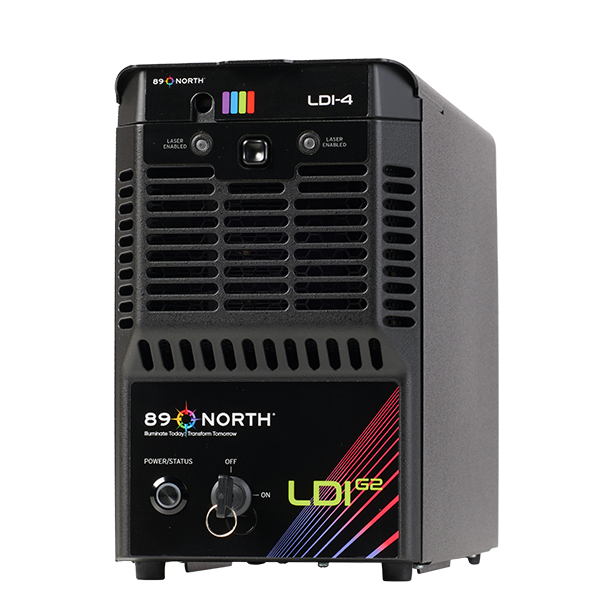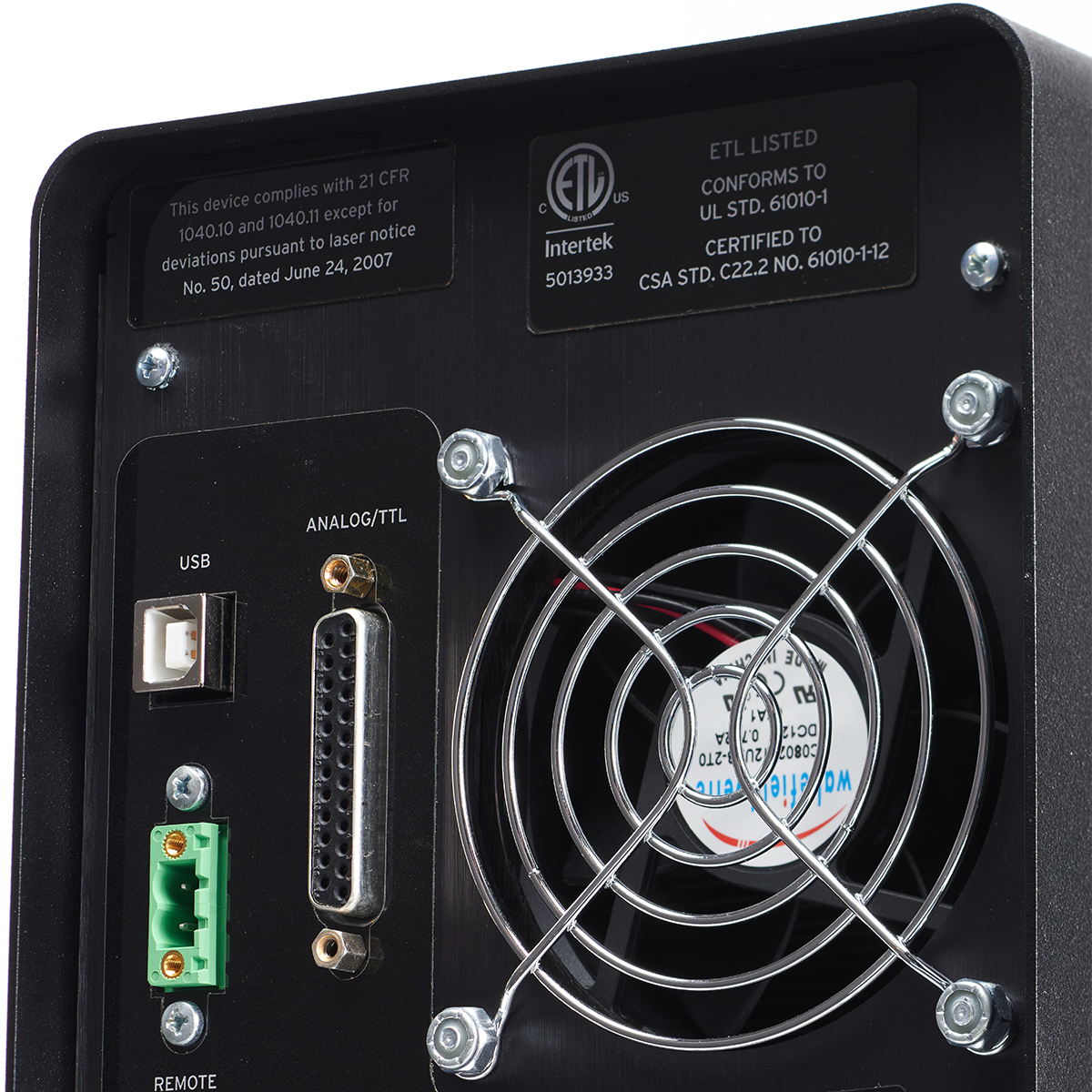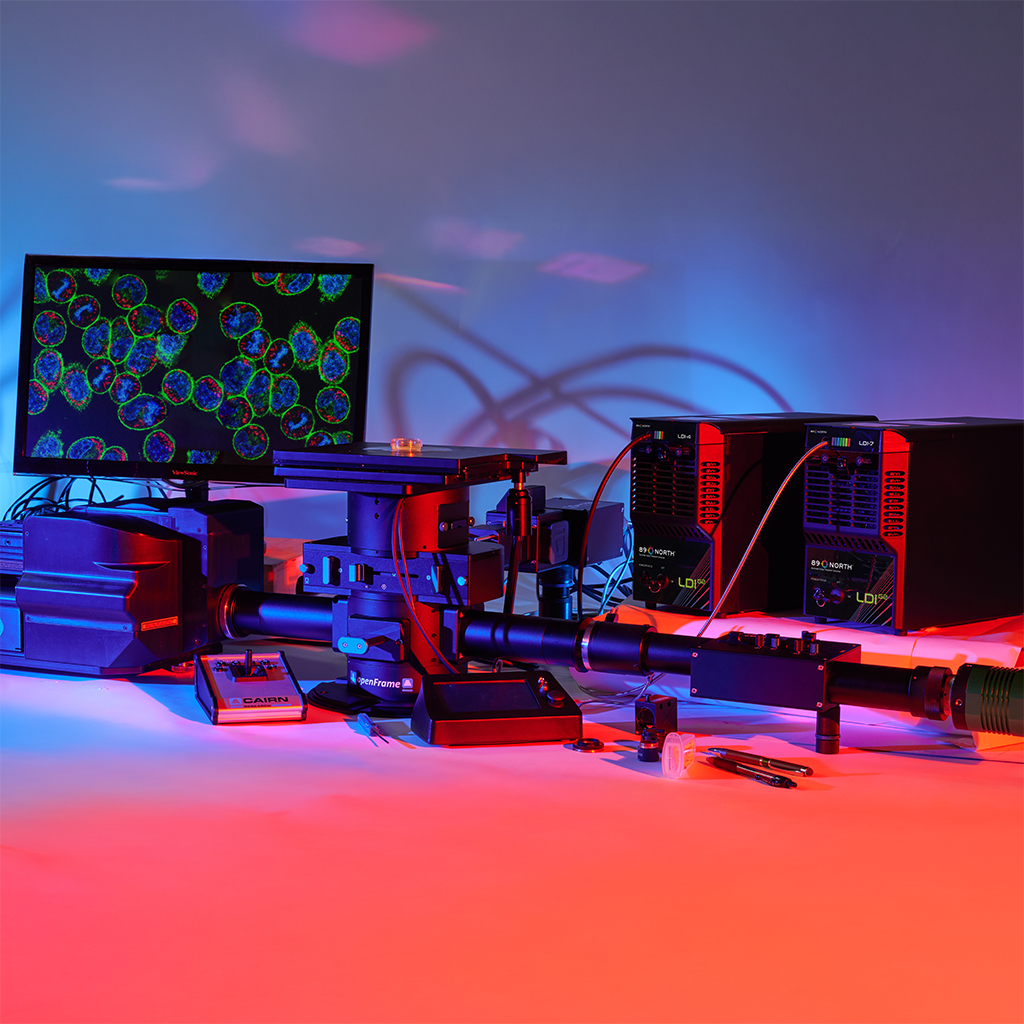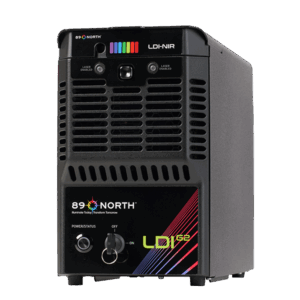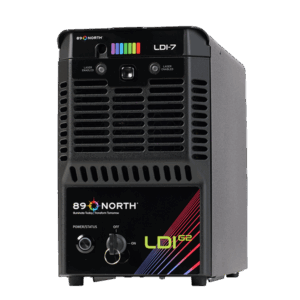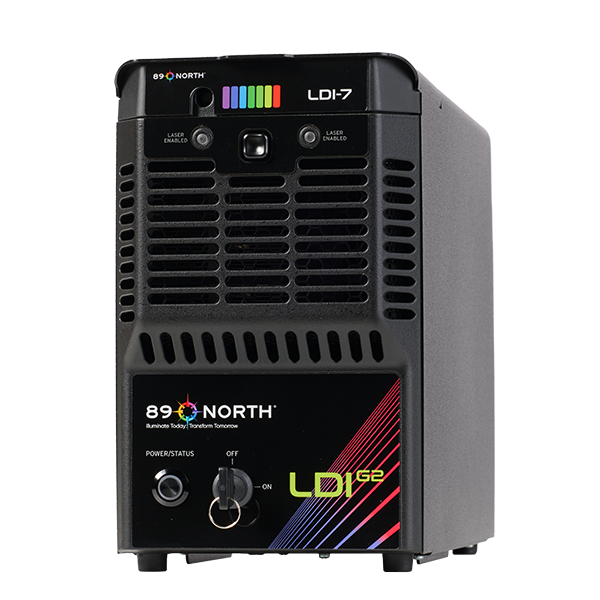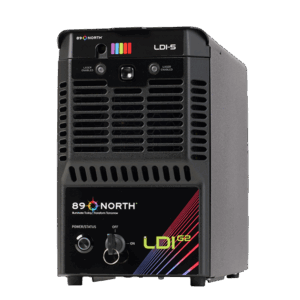LDI-G2-4 Series Overview
The LDI-G2-4 is a streamlined, next-generation illuminator designed around the laser lines corresponding to the four most widely fluorescent stains (or fluorescent molecules): DAPI, FITC, TRITC, and Cy5. Researchers asked for simplicity without compromise, and we delivered. With the new G2 architecture, you’ll see higher power density, improved beam quality, and rock-solid stability—ensuring sharper illumination and reproducible results for your essential imaging applications. Options are also available with 488 nm for FITC/GFP and 577 nm for TRITC/mCherry… or both.
Have questions about the specifications or capabilities? >> Ask an Engineer
Specifications
Find specifications for our LDI-G2-4 line of products below. Note that we can also work with you to provide solutions for your unique needs.
| Source Type | Laser Diodes | |||
| Laser Line (nm) | 405 | 470 or 488 | 555 or 577 | 640 |
| Continuous Wave Stability1 (typical values) | < 0.2% | < 0.2% | < 0.2% | < 0.2% |
| Optical Power Min (mW)2 | 300 | 10005 | 700 or 5006 | 500 |
| Max Rise Time2 (typical values) | < 5μs | < 5μs | < 2 ms | < 5μs |
| Max On/Off Frequency (Hz)3 | > 1000 | > 1000 | 100 | > 1000 |
| Output Options | Optical fiber ⁴ | |||
| Control Options | TTL (>2.3 V) Analog (0–5 V) USB–DSP (virtual COM port) – SDK available upon request |
|||
| Safety | Interlocked housing Safety interlock Key interlock IEC 60825 compliant |
|||
| Dimensions | 12.5” x 9.2” x 5.75”, 318mm x 234mm x 146mm | |||
| Weight | ~9 lbs | |||
| Operating Temperature | 15-30° C | |||
| Storage Temperature | -18-50° C | |||
| Humidity | < 80% non-condensing | |||
| Voltage | 90–220 V AC, 50–60 Hz | |||
| Fuse | None | |||
| Warranty |
2 Years | |||
1. Defined in accordance with the QUAREP-LiMi WG 1 standard, “Illumination Power, Stability, and Linearity Measurements for Confocal and Widefield Microscopes V.2”, Section 8, with power output measured at the fiber output.
2. Measured at 100% intensity, 23°C ± 2°C.
3. Measured at 100% intensity, 50% duty cycle.
4. Recommended output fiber is 400 μm, 0.39 NA fiber.
5. 488 nm optical power min preliminary estimate. Actual output power pending product release.
6. 577 nm optical power min preliminary estimate. Actual output power pending product release.
Features
Find the unique features of our LDI-G2-4 line up below.
| Higher Power Density | Shorter exposures and faster imaging Higher throughput through spinning disks Reduced overall run time for high content experiments |
| Improved Optical Stability | Consistent excitation over time Reduced experimental variability |
| Precise and Linear Intensity Control | Optimize light level while minimizing photobleaching and phototoxicity Light output power is linear as a function of intensity setting |
| 4 Laser Lines Across the Spectrum | Covers most of the basic fluorescence probes |
| No User Alignment | Easy to use and maintain Seamless integration with a wide range of microscopy platforms |
| TTL and Analog Control Options | No need for software specific drivers |
Scientific Applications & Techniques
Our LDI-G2-4 light engines are used in some of the worlds most advanced laboratories in a wide range of applications and techniques. These include those listed below.
|
|
Downloadable Documents
Please find links below to relevant downloads for our products.
LDI-G2 Series Frequently Asked Questions (FAQs)
Here are answers to some of the most frequently asked questions we receive. Have further questions? >> Ask Our Engineers
The G2 line builds off the strengths of the earlier version, while adding:
- Increased power density: With a smaller core diameter and single fiber output, the same optical power is concentrated into a smaller area, which increases the intensity at the fiber output.
- Improved beam quality / coupling efficiency: a smaller fiber often helps produce a cleaner, more stable output profile, depending on how the mode is managed.
- Enhanced stability: the new configuration reduces fluctuation.
We developed this new product line to better serve researchers through:
- Delivering sufficient power density at the sample for demanding imaging techniques.
- Ensuring enhanced illumination stability to support long-term experiments and reproducibility.
- Providing efficient light delivery through fibers with minimal losses.
- Offering a system that supports advanced microscopy modalities without compromise.
Some of the key benefits of the G2 for researchers include:
- A significant increase in power density by optimizing fiber core size (from 1.5 mm to 400 µm), enabling brighter, sharper illumination.
- Dramatic improvements in stability, ensuring consistent excitation over time and reducing experimental variability.
- More efficient coupling of laser light into the fiber, maximizing usable output.
- Seamless integration with a wide range of microscopy platforms.
Researcher who may be benefit from using the G2 include:
- Life sciences researchers advancing fluorescence and live-cell imaging.
- Biomedical engineers developing or refining imaging systems.
- Core facilities supporting diverse imaging needs across multiple user groups.
Specifically, G2 will benefit the following researchers:
- Cell biologists studying dynamic or delicate processes where signal consistency is vital.
- Neuroscientists performing optogenetics or calcium imaging that require precise, stable illumination.
- Microscopists applying super-resolution methods (e.g., STORM, PALM, SIM) that demand both high power density and stable performance.
- Pathologists leveraging digital imaging for translational and clinical research.
Critical support for our claims include:
- Quantitative performance data: side-by-side output and stability measurements highlighting the higher power density and improved consistency.
- Application-driven results: microscopy images showing enhanced signal-to-noise and resolution.
- External validation: early users and collaborators confirming reproducibility and system performance in real research workflows.
- Benchmarking vs. common alternatives: demonstrating higher efficiency and stability compared to standard fiber-coupled laser sources.
Our Light Engines Are Peer Reviewed in Scientific Publications
Our light engines are used in some of the most pioneering labs across the world. Here are some of the scientific citations we’ve received.
-
Kyle Newton
Lateral line ablation by ototoxic compounds results in distinct rheotaxis profiles in larval zebrafish.
-
Barth D. Grant
Large vesicle extrusions from C. elegans neurons are consumed and stimulated by glial-like phagocytosis activity of the neighboring cell.
-
Adriana San-Miguel
Endogenous DAF-16 spatiotemporal activity quantitatively predicts lifespan extension induced by dietary restriction.
-
Heidi Hehnly
Rab11 endosomes and Pericentrin coordinate centrosome movement during pre-abscission in vivo
Our Products are Used in the Nation's Most Advanced Labs
Our LDI products are used in some of the nation’s most advanced laboratories. Here are a few.






Request A Quote
Contact us for a free quote. Need something bespoke? We can work with you to configure a specialized range of laser lines and options.

Related Products
Related products
-
89 North
LDI-G2-NIR Series Laser Diode Illuminator
The LDI-G2-NIR takes the proven performance of the G2 family and pushes it further into the near-infrared spectrum. Offering exceptional power density and stable excitation in both visible and NIR wavelengths, it opens new possibilities for deep-tissue imaging, optogenetics, and advanced fluorescence applications. Researchers can count on the LDI-G2-NIR to deliver consistent, reproducible illumination in experiments where clarity and stability are critical.
(0 reviews) -
89 North
LDI-G2-7 Series Laser Diode Illuminator
The LDI-G2-7 is the versatile workhorse of the family, offering up to 1000 mW of output power per line through a single multimode fiber. Built for high-performance and long-term reproducibility, this illuminator delivers the intensity and stability needed for demanding modalities such as spinning disk confocal, structured illumination microscopy (SIM), FRAP, and photoactivation/ photoconversion. With its dramatically improved stability and coupling efficiency, the LDI-G2-7 provides world-class performance at a cost-effective price point.
(0 reviews) -
89 North
LDI-G2-5 Series Laser Diode Illuminator
The LDI-G2-5 builds on the G2 platform with expanded power and spectral reach. Alongside the core visible lines, it extends into the near-infrared with a 730 nm channel—ideal for deep-tissue imaging and multiplexing imaging techniques. Combining brighter illumination with enhanced stability, the LDI-G2-5 gives researchers confidence in their results across both traditional and cutting-edge applications. As with the 4-line model, optional 488 nm and 577 nm lasers can be included for GFP and mCherry imaging.
(0 reviews)


 Washington University in St. Louis
Washington University in St. Louis
 Rutgers University
Rutgers University
 NC State University
NC State University
 Syracuse University
Syracuse University

